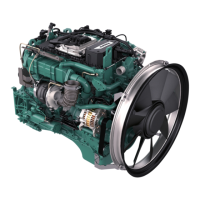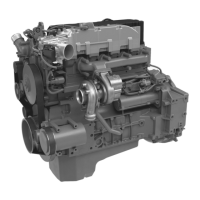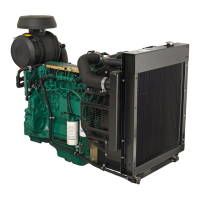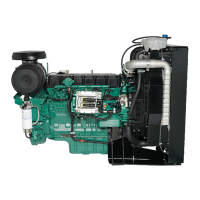Do you have a question about the Volvo Penta TAD572VE and is the answer not in the manual?
Read safety precautions carefully; follow local instructions and regulations.
Ensure good ventilation, avoid ignition sources, and be aware of fire hazards.
Use correct spare parts, handle used oils, filters, and chemicals responsibly.
Safety for rotating parts, hot surfaces, and engine starting prohibition.
Safety before electrical work, welding, and protecting electronic modules.
Precautions for hot coolant/oil, refueling, and preventing burns.
Proper fuel quality, leak detection, and safe battery handling to prevent fire and explosion.
Correct battery polarity and risks associated with corrosive electrolyte.
Maintain component cleanliness and perform adjustments with the engine stopped.
Regular servicing and genuine Volvo Penta parts ensure reliability and long life.
Diagram and list of components for the Exhaust Aftertreatment System.
Guidelines for heating, storage, and safe operation of the AdBlue/DEF system.
Understanding ALARM (red), WARNING (yellow), and MESSAGE (blue) notifications.
Check oil level, fuel pre-filter, leakage, and coolant level before starting.
Engine pre-heating and starter motor operation sequence.
Never use start spray due to explosion risk in the inlet manifold.
Procedure for connecting auxiliary batteries safely to start the engine.
Interpreting fault codes, lamps, and audible warnings from the EMS.
Run engine at high idle for 5 minutes after normal use to equalize temperature and cool turbochargers.
Monitors, controls, and protects the engine; informs of faults via fault codes.
How to access and interpret fault codes and messages on the DCU II display.
Table of symptoms and possible causes for engine malfunctions.
How the EATS system warns of faults or low AdBlue/DEF levels, and engine responses.
Checks for common quality issues and component connection problems in the EATS system.
How low tank level or faults affect engine torque, speed, and operation.
List of SPN, FMI codes and their corresponding components for fault identification.
Information on standard service intervals and where to find the Service Protocol.
Consequences of filling diesel into AdBlue/DEF tank or vice-versa, and how to avoid it.
Read safety precautions carefully; follow local instructions and regulations.
Ensure good ventilation, avoid ignition sources, and be aware of fire hazards.
Use correct spare parts, handle used oils, filters, and chemicals responsibly.
Safety for rotating parts, hot surfaces, and engine starting prohibition.
Safety before electrical work, welding, and protecting electronic modules.
Precautions for hot coolant/oil, refueling, and preventing burns.
Proper fuel quality, leak detection, and safe battery handling to prevent fire and explosion.
Correct battery polarity and risks associated with corrosive electrolyte.
Maintain component cleanliness and perform adjustments with the engine stopped.
Regular servicing and genuine Volvo Penta parts ensure reliability and long life.
Diagram and list of components for the Exhaust Aftertreatment System.
Guidelines for heating, storage, and safe operation of the AdBlue/DEF system.
Understanding ALARM (red), WARNING (yellow), and MESSAGE (blue) notifications.
Check oil level, fuel pre-filter, leakage, and coolant level before starting.
Engine pre-heating and starter motor operation sequence.
Never use start spray due to explosion risk in the inlet manifold.
Procedure for connecting auxiliary batteries safely to start the engine.
Interpreting fault codes, lamps, and audible warnings from the EMS.
Run engine at high idle for 5 minutes after normal use to equalize temperature and cool turbochargers.
Monitors, controls, and protects the engine; informs of faults via fault codes.
How to access and interpret fault codes and messages on the DCU II display.
Table of symptoms and possible causes for engine malfunctions.
How the EATS system warns of faults or low AdBlue/DEF levels, and engine responses.
Checks for common quality issues and component connection problems in the EATS system.
How low tank level or faults affect engine torque, speed, and operation.
List of SPN, FMI codes and their corresponding components for fault identification.
Information on standard service intervals and where to find the Service Protocol.
Consequences of filling diesel into AdBlue/DEF tank or vice-versa, and how to avoid it.
| Brand | Volvo Penta |
|---|---|
| Model | TAD572VE |
| Category | Engine |
| Language | English |











